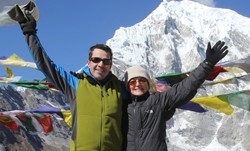
Name
Martin Wiedmann, Ph.D.
Title
Professor, Department of Food Science
Institution
Cornell University
Education
DVM, Veterinary Medicine, University of Munich, Germany; Dr. (med. vet.), Veterinary Medicine, University of Munich, Germany; Ph.D., Food Science, Cornell University
What brought you to Cornell University?
My introduction to Cornell was random luck; one day I walked into a professor’s office at the School of Veterinary Medicine in Munich and asked him where I could do an internship in virology in the United States. My professor basically told me to write to a colleague of his at Cornell University to see whether he would be able to take me for a summer. I had no idea what or where Cornell was, but contacted the colleague anyway and spent the summer of 1991 at an internship at Cornell University. After I completed that internship, I returned to Germany and finished my veterinary degree in Munich. In 1992, I returned to the United States, resumed my education at Cornell and never left. I received my Ph.D. in Food Science in 1997, was a post-doctoral researcher there for two years and accepted a faculty position in 1999. I have been teaching at Cornell University ever since.
How did you learn about the Center for Produce Safety?
I first heard about the Center for Produce Safety through contacts at Wegmans. At Cornell (especially in the Food Science field) we have a lot of connections with the Wegmans company. Food safety is very important to Wegmans and we collaborate with them frequently.
Why did you apply for funding from CPS?
I wanted to provide better quantitative data regarding the pre-harvest riparian zones with relation to food safety. I saw an opportunity to increase food safety in produce and communicate it to the general public and industry more quickly.
In 2011 CPS funded your project “The role of riparian zones in bacteria dispersal to produce farms." Are there any recent updates from this project?
We have finished the field study part of the project, collecting more than 2,800 E. coli specimens from more than 500 samples, which each have been mapped by GIS. The sampling sites represented two distinct produce pre-harvest environments; one landscape was largely dominated by forests and one was dominated by agricultural land. The more forested landscape showed a higher E. coli prevalence in soils, giving us evidence that forests had a higher E. coli prevalence than fields. While this may suggest that wildlife might be important for E. coli dispersal, other factors could also contribute to this observation (e.g., that forested areas favor E. coli survival). The final part of this work, which includes modeling efforts to examine dispersal (movement) distances or rates among sites, will be critical to determine if and what type of wildlife movement contributes to E. coli dispersal into produce fields.
What do you think the industry will gain from your research project?
Overall, my research group looks at transmission of foodborne pathogens throughout the whole chain in order to provide insight on how to improve food safety from start to finish. This specific research project (referenced above) will provide new insight as to how wildlife may transmit pathogens into produce fields and what landscape factors may facilitate or prevent pathogen dispersal through wildlife. This will allow for development of science-based landscape specific guidance on how to co-manage wildlife habitats and produce food safety.
Where do you see the field of food safety research 5 years down the road? Why?
I see three things happening:
What are the key factors influencing this field of inquiry?
The intersection of policy and politics and research and industry strongly influences produce safety and food safety research in general. We need more field research in commercial (or at least nearly commercial) facilities to better understand how to produce safer food. Unfortunately, some regulatory agencies and lawyers have often set the stage for an environment that is unfriendly towards field research that has the potential to find evidence for presence of pathogens. We need to work together to get beyond this potential roadblock.
Aside from working in the laboratory, how else do you spend your time?
I enjoy fly-fishing, hiking, and traveling. I try and make sure I visit my family in Germany every year, but I also make time to take trips all over the world to visit the best places to fly-fish. One destination, in particular, is Kamchatka, Russia, which is extremely remote -- you have to get flown in by helicopter and it’s a 6-day trip down river in the remote wilderness. It not only has some of the best fly-fishing in the world, but it also has a beautiful landscape with an abundance of wildlife. Another one of my favorite locales to fly-fish is Tierra del Fuego and other parts of Patagonia, both in Argentina and Chile.
Describe one or more of your career highlights
My biggest career highlight is being in a position to train and teach others to go into their field of choice; whether it is government, research, or industry. Having a hand in someone else’s future and being able to help others achieve and complete the next level in their education is very rewarding.